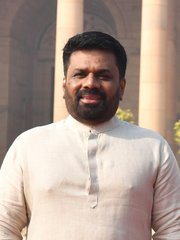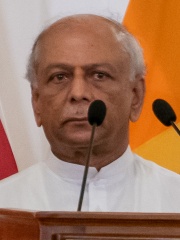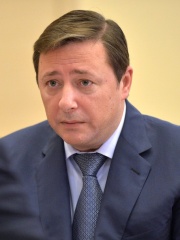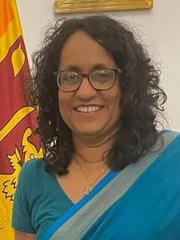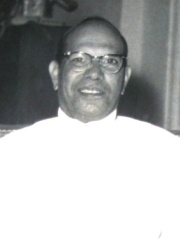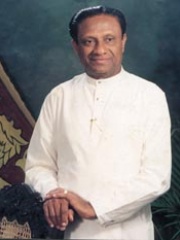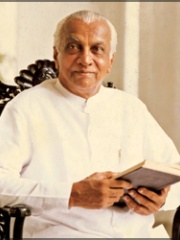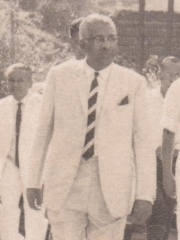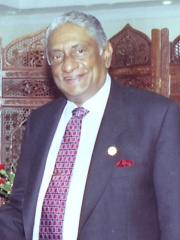
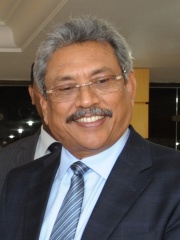
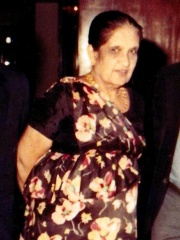
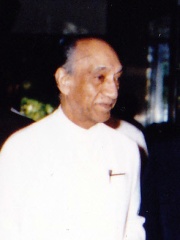
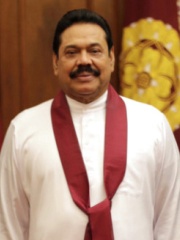
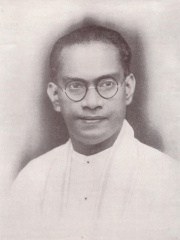
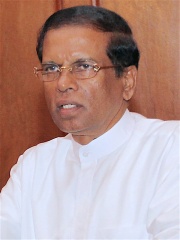
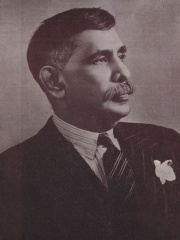
The Most Famous
POLITICIANS from Sri Lanka
This page contains a list of the greatest Sri Lankan Politicians. The pantheon dataset contains 19,576 Politicians, 21 of which were born in Sri Lanka. This makes Sri Lanka the birth place of the 107th most number of Politicians behind Ghana, and Democratic Republic of the Congo.
Top 10
The following people are considered by Pantheon to be the top 10 most legendary Sri Lankan Politicians of all time. This list of famous Sri Lankan Politicians is sorted by HPI (Historical Popularity Index), a metric that aggregates information on a biography's online popularity. Visit the rankings page to view the entire list of Sri Lankan Politicians.

1. Ranil Wickremesinghe (b. 1949)
With an HPI of 75.53, Ranil Wickremesinghe is the most famous Sri Lankan Politician. His biography has been translated into 53 different languages on wikipedia.
Ranil Wickremesinghe (Sinhala: අතිගරු රනිල් වික්රමසිංහ; Tamil: ரணில் விக்கிரமசிங்க; born 24 March 1949) is a Sri Lankan politician who served as the ninth president of Sri Lanka from 2022 to 2024. He has also served as Prime Minister of Sri Lanka from 1993–1994, 2001–2004, 2015–2018, 2018-2019 and in 2022. Wickremesinghe has held several ministerial roles, including Minister of Finance, Minister of Defence, Minister of Technology and Minister of Women, Child Affairs and Social Empowerment. Wickremesinghe has led the United National Party (UNP) since 1994. He is also the eighth executive president of Sri Lanka, a role established by the 1977 constitutional amendment that expanded presidential powers. Born into a political family, Wickremesinghe graduated from the University of Ceylon and qualified as a lawyer from the Ceylon Law College in 1972. He entered politics in the mid-1970s with the UNP, first being elected to Parliament in 1977. Over the years, he held various ministerial positions, including Minister of Foreign Affairs, Youth Affairs and Employment, and Industry, Science and Technology. He first became prime minister in 1993 following the assassination of President Ranasinghe Premadasa. Wickremesinghe ran for president as the UNP candidate in 1999 and 2005, but was defeated both times. In 2015, he was appointed prime minister by president Maithripala Sirisena, leading a national unity government until 2019. During his tenure, he was controversially sacked by Sirisena in 2018, triggering a constitutional crisis, but was reappointed as prime minister after the Supreme Court declared his sacking as unconstitutional. He lost his parliamentary seat in 2020 but re-entered parliament in 2021 as a National List MP. In May 2022, Wickremesinghe was appointed as prime minister by president Gotabaya Rajapaksa amidst the then-ongoing political crisis. Following Rajapaksa's resignation in July 2022, Wickremesinghe assumed the presidency in an acting capacity and was subsequently elected as the 9th president and the 8th executive president of Sri Lanka by parliament on 20 July 2022. He took office the following day. He attempted to run for a full term in his own right in 2024 but failed to win reelection, finishing in third place with 17.27% of the vote.

2. Gotabaya Rajapaksa (b. 1949)
With an HPI of 73.46, Gotabaya Rajapaksa is the 2nd most famous Sri Lankan Politician. His biography has been translated into 48 different languages.
Nandasena Gotabaya Rajapaksa (Sinhala: නන්දසේන ගෝඨාභය රාජපක්ෂ; Tamil: நந்தசேன கோட்டாபய ராஜபக்ஷ; born 20 June 1949) is a Sri Lankan former politician and retired military officer who served as the eighth President of Sri Lanka from 18 November 2019 until his resignation on 14 July 2022. Before his presidency, he served as Secretary to the Ministry of Defence and Urban Development from 2005 to 2015 during the regime of his brother, president Mahinda Rajapaksa, playing a central role in the final phase of the Sri Lankan Civil War. Born to a political family from the Southern Province, Rajapaksa was educated at Ananda College, Colombo and joined the Ceylon Army in April 1971. Following basic training at the Army Training Centre, Diyatalawa, he was commissioned as signals officer and later transferred to several infantry regiments. He saw active service in the early stages of the Sri Lankan Civil War with the elite Gajaba Regiment, taking part in several major offensives such as the Vadamarachi Operation, Operation Strike Hard and Operation Thrividha Balaya, as well as counterinsurgency operations during the 1987–1989 JVP insurrection. As Defence Secretary, he oversaw the military defeat of the Liberation Tigers of Tamil Eelam in 2009. He was a target of an assassination attempt in December 2006 by a Tamil Tiger suicide bomber. After stepping down in 2015 following his brother's electoral defeat, Rajapaksa returned to politics and ran for presidency in 2019 as a candidate of the Sri Lanka Podujana Peramuna. Campaigning on a nationalistic and security-heavy platform, he became the first Sri Lankan president with a military background and no prior elected office experience. His administration mishandled the COVID-19 pandemic response and drove Sri Lanka into an economic crisis, leading the country to default on its debts in 2022. Massive shortages, inflation, and public outrage culminated in nationwide protests and civil unrest. Rajapaksa's government responded with authoritarian crackdowns: state of emergency declarations, curfews, military-led arrests, suppression of dissent, and assaults on journalists and demonstrators. Refusing to resign for months, even as the crisis spiraled, he finally fled Sri Lanka aboard a military aircraft on 13 July 2022, entering self-imposed exile for 50 days. He officially resigned via email from Singapore the next day, becoming the first Sri Lankan president to resign midway into his term. Rajapaksa later returned to Sri Lanka on 2 September 2022.

3. Sirimavo Bandaranaike (1916 - 2000)
With an HPI of 71.36, Sirimavo Bandaranaike is the 3rd most famous Sri Lankan Politician. Her biography has been translated into 78 different languages.
Sirima Ratwatte Dias Bandaranaike (; Sinhala: සිරිමා රත්වත්තේ ඩයස් බණ්ඩාරනායක; Tamil: சிறிமா ரத்வத்தே டயஸ் பண்டாரநாயக்கே; née Ratwatte; 17 April 1916 – 10 October 2000), commonly known as Sirimavo Bandaranaike, was a Sri Lankan politician who became the world's first female prime minister when she was elected Prime Minister of Sri Lanka (then the Dominion of Ceylon) in 1960. She chaired the Sri Lanka Freedom Party (SLFP) from 1960 to 1994, and served three terms as prime minister from 1960 to 1965, from 1970 to 1977, and from 1994 to 2000 under the presidency of her daughter Chandrika Kumaratunga. Born into a Sinhalese Kandyan aristocratic family, Bandaranaike was educated in Catholic, English-medium schools, but remained a Buddhist, and spoke Sinhala as well as English. As a hostess for her husband S. W. R. D. Bandaranaike, who founded the socialist SLFP in 1951 and became prime minister in 1956, she became an informal advisor, and focused on improving the lives of women and girls in rural areas of Sri Lanka. Following her husband's assassination in 1959, she was persuaded by the party leadership to join active politics and succeed her late husband as chairwoman, and returned her party to government by defeating prime minister Dudley Senanayake's UNP in the July 1960 election. She was then unseated by Senanayake in the 1965 election and became Leader of the Opposition, before winning a large majority in 1970 due to a cleverly structured election alliance with rival Marxist parties. Bandaranaike attempted to reform the former Dominion of Ceylon into a socialist republic by nationalising organisations in the banking, education, industry, media and trade sectors. Changing the administrative language from English to Sinhala and routinely campaigning on Sinhalese nationalist and anti-Tamil policies exacerbated discontent among the native Tamil population, and with the estate Tamils, who had become stateless under the Citizenship Act of 1948. During Bandaranaike's first two terms as prime minister the country experienced high unemployment, inflation and taxes, and became dependent on food imports. Surviving an attempted coup d'état in 1962, as well as a 1971 insurrection of radical youths, in 1972 she oversaw the drafting of a new constitution and the formation of the Sri Lankan republic, separating it from the British Empire. In 1975, Bandaranaike created what would eventually become the Sri Lankan Ministry of Women and Child Affairs, and played a large role abroad as a negotiator and a leader among the Non-Aligned Nations. After losing against J. R. Jayewardene in a landslide in the 1977 election, Bandaranaike was stripped of her civil rights in 1980 for claimed abuses of power during her tenure and barred from government for seven years. The new government initially improved the domestic economy, but failed to address social issues, and led the country into a protracted civil war against Tamil militants, which escalated in brutality, especially when the Indian Peace Keeping Force intervened. Bandaranaike opposed the Indian intervention, believing it violated Sri Lankan sovereignty. Failing to win the office of President against new UNP leader Ranasinghe Premadasa in 1988, she restored her party, which had by now developed more centrist policies and advocated for a reconciliatory approach towards Tamils in the civil war, as a relevant force in the first parliamentary election after 12 years and served a second time as Leader of the Opposition from 1989 to 1994. When her daughter, who succeeded her as party leader, won the 1994 presidential election, Bandaranaike was appointed to her third term as prime minister and served until her retirement in 2000, two months prior to her death.

4. J. R. Jayewardene (1906 - 1996)
With an HPI of 67.88, J. R. Jayewardene is the 4th most famous Sri Lankan Politician. His biography has been translated into 35 different languages.
Junius Richard Jayewardene (Sinhala: ජුනියස් රිචඩ් ජයවර්ධන; Tamil: ஜூனியஸ் ரிச்சட் ஜயவர்தனா; 17 September 1906 – 1 November 1996), commonly referred to by his initials JR, was a Sri Lankan lawyer, public official and statesman who served as Prime Minister of Sri Lanka from 1977 to 1978 and as the second President of Sri Lanka from 1978 to 1989. He was a leader of the nationalist movement in Ceylon (now Sri Lanka) and served in a variety of cabinet positions in the decades following independence. A longtime member of the United National Party, he led the party to a landslide victory in the 1977 parliamentary elections and served as prime minister for half a year before becoming the country's first executive president under an amended constitution. Jayawardena remains a divisive figure in Sri Lankan history. While the open economic system he introduced in 1978 brought the country out of the economic turmoil it was facing as the result of the preceding government's closed economic policies, Jayawardene's social policies, including his response to the Black July riots of 1983, have been accused of heightening ethnic tensions in the country and contributing to the beginnings of the Sri Lankan civil war.
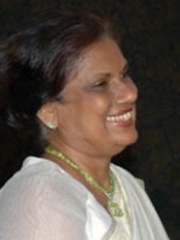
5. Chandrika Kumaratunga (b. 1945)
With an HPI of 65.73, Chandrika Kumaratunga is the 5th most famous Sri Lankan Politician. Her biography has been translated into 62 different languages.
Chandrika Bandaranaike Kumaratunga (Sinhala: චන්ද්රිකා බණ්ඩාරනායක කුමාරතුංග; Tamil: சந்திரிகா பண்டாரநாயக்க குமாரதுங்க; née Bandaranaike; born 29 June 1945), commonly referred to by her initials CBK, is a Sri Lankan politician who served as the fifth president of Sri Lanka from 12 November 1994 to 19 November 2005. She is the longest-serving president in Sri Lankan history. She led the Sri Lanka Freedom Party (SLFP) from 1994 to 2006. Born in 1945 into a prominent Sri Lankan political family, she is the daughter of two former prime ministers, Solomon Bandaranaike and Sirimavo Bandaranaike. Kumaratunga entered politics in the 1970s, initially focusing on social welfare and rural development. After spending several years in exile following the assassination of her husband, Vijaya Kumaratunga, she returned to Sri Lanka in the late 1980s. In 1993, she was elected Chief Minister of the Western Province. The following year, after becoming the leader of the Sri Lanka Freedom Party, she formed the People's Alliance and led her coalition to victory in the 1994 parliamentary elections. In the presidential election held later that year, she was elected as the first female president of Sri Lanka, defeating UNP candidate Srima Dissanayake in the largest landslide victory in Sri Lankan history, securing almost 62% of the votes. In the 1999 election, Kumaratunga survived an assassination attempt during her re-election campaign and went on to win a second term, defeating UNP candidate and Leader of the Opposition, Ranil Wickremesinghe. She was responsible for the modernisation of the SLFP and the broader Sri Lankan left under the banner of “capitalism with a human face.” This marked a decisive shift from the inward-looking, state-controlled economic policies of earlier SLFP administrations. Kumaratunga’s approach maintained a market-oriented economy while emphasising equity and social protection, contributing to improved economic performance and broadening the appeal of her party. She also played a key role in restoring a degree of normalcy to public life following the turbulence of the late 1980s and early 1990s, a period marked by political violence, state repression, and widespread insecurity during and after the Ranasinghe Premadasa presidency. Her administration focused on re-establishing democratic norms and reducing extra-judicial violence to bring on greater political stability. During her presidency, Kumaratunga pursued peace negotiations with the Liberation Tigers of Tamil Eelam (LTTE) in an effort to resolve the country’s long-running civil conflict. After the collapse of peace negotiations, Kumaratunga launched a military campaign known as the “War for Peace” during the Eelam III phase of the Sri Lankan Civil War - one of the conflict’s most intense and brutal periods of fighting. As part of a broader strategy to simultaneously isolate the LTTE politically and financially while pursuing a military solution, she succeeded in securing the group’s international isolation: many major states formally designated the LTTE a terrorist organization, cutting off key sources of funding and delivering a significant blow to its global propaganda network. Her administration also introduced a major package of constitutional reforms, the "2000 Constitution", aimed at abolishing the executive presidency and devolving power to the Tamil people. However, the proposed reforms were never implemented due to the withdrawal of support from the opposition. Her tenure was marred by criticism of her use of presidential powers and by allegations of corruption within her administration.

6. Mahinda Rajapaksa (b. 1945)
With an HPI of 63.27, Mahinda Rajapaksa is the 6th most famous Sri Lankan Politician. His biography has been translated into 63 different languages.
Mahinda Rajapaksa (Sinhala: මහින්ද රාජපක්ෂ; Tamil: மஹிந்த ராஜபக்ஷ; born Percy Mahendra Rajapaksa; 18 November 1945) is a Sri Lankan politician. He served as the sixth President of Sri Lanka from 2005 to 2015; the Prime Minister of Sri Lanka from 2004 to 2005, 2018, and 2019 to 2022; the Leader of the Opposition from 2002 to 2004 and 2018 to 2019, and the Minister of Finance from 2005 to 2015 and 2019 to 2021. Rajapaksa is a lawyer by profession and was first elected to the Parliament of Sri Lanka in 1970. He served as the leader of the Sri Lanka Freedom Party from 2005 to 2015. Rajapaksa was sworn in for his first six-year term as president on 19 November 2005. He was subsequently re-elected in 2010 for a second term. Rajapaksa was defeated in his bid for a third term in the 2015 presidential election by Maithripala Sirisena, and he left office on 9 January 2015. Later that year, Rajapaksa unsuccessfully sought to become prime minister in the 2015 parliamentary election; that year, the United People's Freedom Alliance was defeated but Rajapaksa was elected as a Member of Parliament for the Kurunegala District. On 26 October 2018, Rajapaksa was controversially appointed to the office of prime minister by president Maithripala Sirisena after the UPFA withdrew from the unity government. The incumbent, Ranil Wickremesinghe, refused to accept his dismissal, stating that it was unconstitutional. This disagreement resulted in a constitutional crisis. The Sri Lankan Parliament passed two no-confidence motions brought against Rajapaksa on 14 and 16 November 2018. Failing to follow proper procedures, president Sirisena rejected both. On 3 December 2018, a court suspended Rajapaksa's powers as prime minister, ruling that his cabinet could not function until establishing its legitimacy. Rajapaksa resigned from the post of prime minister on 15 December 2018. Wickremesinghe was re-appointed as prime minister, and Rajapaksa was appointed Leader of the Opposition. Rajapaksa became the leader of the Sri Lanka Podujana Peramuna in 2019, a proxy of the former president that had split from the Sri Lanka Freedom Party. He became prime minister again on 21 November 2019 after being appointed by his brother, Gotabaya Rajapaksa, who had become president on 18 November after winning the 2019 presidential election. On 9 August 2020, Rajapaksa was sworn in as Prime Minister of Sri Lanka for the fourth time at a Buddhist temple on Colombo's outskirts. On 3 May 2022, a motion of no confidence aimed at Rajapaksa and his cabinet was declared by opposition leaders. He was targeted during the 2022 Sri Lankan protests over the corruption and mismanagement by the Rajapaksa family which led to an economic crisis that brought Sri Lanka to the point of bankruptcy as it defaulted on its loans for the first time in its history since independence. Protesters called him "Myna" and demanded his resignation which he resisted. On 9 May 2022, Mahinda Rajapaksa organised his supporters at his official residence who were brought by buses and led by SLPP MPs. The loyalists then attacked protestors at Temple Trees before assaulting protestors at Galle Face as attacks were carried out simultaneously against protests in other areas; however this intensified protests and retaliatory violence against Rajapaksa loyalists erupted islandwide and Mahinda Rajapaksa submitted his letter of resignation the same day. During Rajapaksa's political career, he has been accused of multiple crimes including war crimes during the last years of the Sri Lankan civil war as well as other criminal accusations including human rights violations during his presidency, corruption and for instigating violence on anti-government protestors on 9 May 2022. As of 2023 he has been sanctioned by Canada for human rights violations.

7. S. W. R. D. Bandaranaike (1899 - 1959)
With an HPI of 60.62, S. W. R. D. Bandaranaike is the 7th most famous Sri Lankan Politician. His biography has been translated into 35 different languages.
Solomon West Ridgeway Dias Bandaranaike (8 January 1899 – 26 September 1959), also known as "The Silver Bell of Asia" (ආසියාවේ රිදී සීනුව), was a Sri Lankan statesman who served as the fourth Prime Minister of the Dominion of Ceylon (now Sri Lanka), serving from 1956 until his assassination in 1959. The founder of the left-wing and Sinhalese nationalist Sri Lanka Freedom Party, he was elected the fourth Prime Minister of Ceylon after creating a powerful coalition called the Mahajana Eksath Peramuna and contesting on the lines of Sinhalese nationalism and democratic socialism. He achieved a landslide victory over the ruling United National Party in the general elections in 1956. His tenure saw some of the first left wing reforms instituted by the Freedom Party in Sri Lanka such as the nationalizing bus services and introducing legislation to prohibit caste based discrimination. Bandaranaike further consolidated Sri Lanka's newly gained independence by formally abrogating the 1947 United Kingdom–Ceylon Defence Agreement and establishing diplomatic missions with a number of communist states. He implemented a new language policy, the Sinhala Only Act, making Sinhala the sole official language of the country, creating much controversy. On 25 September 1959, Bandaranaike was shot at his town house in Colombo and died of his wounds the day after. A Buddhist monk named Ven Talduwe Somarama was arrested, convicted and hanged for the murder of Bandaranaike. Minister of Education and the acting leader of the house, Wijeyananda Dahanayake was appointed caretaker prime minister by the Governor General and was confirmed by Parliament. Bandaranaike's widow Sirima Ratwatte Dias Bandaranaike led the Freedom Party to gain a majority in parliament and was elected the first female prime minister in the world. She expanded on her husband's left-wing reforms in her two terms as prime minister from 1960 to 1964 and from 1970 to 1977. In 1994, Bandaranaike's daughter Chandrika Kumaratunga headed a coalition led by the Freedom Party to be elected prime minister and thereafter president serving from 1994 to 2005 and Bandaranaike's son Anura Bandaranaike served as Speaker of the Parliament of Sri Lanka from 2000 to 2001.

8. Maithripala Sirisena (b. 1951)
With an HPI of 59.82, Maithripala Sirisena is the 8th most famous Sri Lankan Politician. His biography has been translated into 54 different languages.
Maithripala Yapa Sirisena (Sinhala: පල්ලෙවත්ත ගමරාළලාගේ මෛත්රීපාල යාපා සිරිසේන; Tamil: பல்லேவத்த கமராளலாகே மைத்திரிபால யாப்பா சிறிசேன; born 3 September 1951) is a Sri Lankan politician who served as the seventh president of Sri Lanka from 9 January 2015 to 18 November 2019. Sirisena is Sri Lanka's first president from the North Central Province of the country and does not belong to the traditional Sri Lankan political elite. He served as a member of parliament from Polonnaruwa from 1989 to 2015 and from 2020 to 2024. Sirisena joined mainstream politics in 1989 as a member of the Parliament of Sri Lanka and has held several ministries since 1994. He was the general-secretary of the Sri Lanka Freedom Party and was Minister of Health until November 2014 when he announced his candidacy in the 2015 presidential election as the "common candidate" of a coalition of opposition parties, running against party leader and incumbent president Mahinda Rajapaksa. His victory in the election was generally viewed as an upset, coming to office through votes won from the alternative Sinhala-majority rural constituency and the Tamil and Muslim minority groups that were alienated by the Rajapaksa government on post-war reconciliation and growing sectarian violence. Sirisena pledged to implement a 100-day reform program where he promised to rebalance the executive branch within 100 days of being elected. This plan included reinforcing Sri Lanka's judiciary and parliament, investigation of alleged war crimes during the final stages of the Sri Lankan civil war, repealing the controversial eighteenth amendment and re-instating the seventeenth amendment, reducing corruption and appointing UNP leader Ranil Wickremesinghe as prime minister. He later was reported to have publicly disavowed this program, claiming that he did not know where it originated. Sirisena was sworn in as the sixth Executive President before Supreme Court judge K. Sripavan in Independence Square, Colombo at 6:20 p.m. on 9 January 2015. Immediately afterwards he appointed Ranil Wickremesinghe as the new prime minister. After being sworn in, Sirisena stated that he would only serve one term. Sirisena voluntarily transferred significant presidential powers to parliament on 28 April 2015. In 2018, Sirisena appointed former president Mahinda Rajapaksa as the prime minister, wrote a letter firing prime minister Ranil Wickremesinghe and prorogued Parliament, instigating a constitutional crisis. Sirisena's actions were later declared as unconstitutional by the Supreme Court and Wickremesinghe was promptly reinstated as the prime minister.

9. D. S. Senanayake (1883 - 1952)
With an HPI of 59.32, D. S. Senanayake is the 9th most famous Sri Lankan Politician. His biography has been translated into 23 different languages.
Don Stephen Senanayake (Sinhala: දොන් ස්ටීවන් සේනානායක; Tamil: டி. எஸ். சேனநாயக்கா; 20 October 1884 – 22 March 1952) was a Ceylonese statesman. He was the first Prime Minister of Ceylon, having emerged as the leader of the Sri Lankan independence movement that led to the establishment of self-rule in Ceylon. He is considered as the "Father of the Nation". Born to an entrepreneur from the village of Botale, Senanayake was educated at S. Thomas' College, Mutwal before briefly working as a clerk in the Surveyor General's Department. Joining the family business, he managed the family estates and the Kahatagaha Graphite Mine. Along with his brothers, Senanayake became active in the temperance movement which grew into the independence movement following 1915 Sinhalese-Muslim riots, in which the Senanayake brothers were imprisoned without charges for 46 days. He was elected unopposed in 1924 to the Legislative Council of Ceylon from Negombo, becoming the Secretary of the unofficial members group of the Legislative Council. In 1931, he was elected to the State Council of Ceylon, where he served as Minister of Agriculture and Lands. He was elected to the first Parliament of Ceylon forming a government and serving as Ceylon's first Prime Minister from 1947 until his death in 1952.

10. Ratnasiri Wickremanayake (1933 - 2016)
With an HPI of 57.29, Ratnasiri Wickremanayake is the 10th most famous Sri Lankan Politician. His biography has been translated into 34 different languages.
Ratnasiri Wickremanayake (Sinhala: රත්නසිරි වික්රමනායක, Tamil: ரத்னசிறி விக்கிரமநாயக்க; 5 May 1933 – 27 December 2016) was a Sri Lankan politician who served as Prime Minister of Sri Lanka from 2000 to 2001 and again from 2005 to 2010, and also served as the Leader of the Opposition from 2001 to 2002. He was a Member of Parliament representing the Horana electorate and later the Kalutara District. Wickremanayake held many ministerial positions in the Sri Lankan government, beginning in 1970.
People
Pantheon has 21 people classified as Sri Lankan politicians born between 1883 and 1970. Of these 21, 9 (42.86%) of them are still alive today. The most famous living Sri Lankan politicians include Ranil Wickremesinghe, Gotabaya Rajapaksa, and Chandrika Kumaratunga. The most famous deceased Sri Lankan politicians include Sirimavo Bandaranaike, J. R. Jayewardene, and S. W. R. D. Bandaranaike. As of April 2024, 2 new Sri Lankan politicians have been added to Pantheon including Anura Kumara Dissanayake, and Harini Amarasuriya.
Living Sri Lankan Politicians
Go to all RankingsRanil Wickremesinghe
1949 - Present
HPI: 75.53
Gotabaya Rajapaksa
1949 - Present
HPI: 73.46
Chandrika Kumaratunga
1945 - Present
HPI: 65.73
Mahinda Rajapaksa
1945 - Present
HPI: 63.27
Maithripala Sirisena
1951 - Present
HPI: 59.82
Anura Kumara Dissanayake
1968 - Present
HPI: 54.77
Dinesh Gunawardena
1949 - Present
HPI: 54.29
Alexander Khloponin
1965 - Present
HPI: 45.82
Harini Amarasuriya
1970 - Present
HPI: 45.80
Deceased Sri Lankan Politicians
Go to all RankingsSirimavo Bandaranaike
1916 - 2000
HPI: 71.36
J. R. Jayewardene
1906 - 1996
HPI: 67.88
S. W. R. D. Bandaranaike
1899 - 1959
HPI: 60.62
D. S. Senanayake
1883 - 1952
HPI: 59.32
Ratnasiri Wickremanayake
1933 - 2016
HPI: 57.29
William Gopallawa
1896 - 1981
HPI: 57.20
D. M. Jayaratne
1931 - 2019
HPI: 55.53
Ranasinghe Premadasa
1924 - 1993
HPI: 55.53
Dingiri Banda Wijetunga
1916 - 2008
HPI: 55.23
Dudley Senanayake
1911 - 1973
HPI: 53.54
John Kotelawala
1897 - 1980
HPI: 51.70
Lakshman Kadirgamar
1932 - 2005
HPI: 47.96
Newly Added Sri Lankan Politicians (2025)
Go to all RankingsOverlapping Lives
Which Politicians were alive at the same time? This visualization shows the lifespans of the 12 most globally memorable Politicians since 1700.

